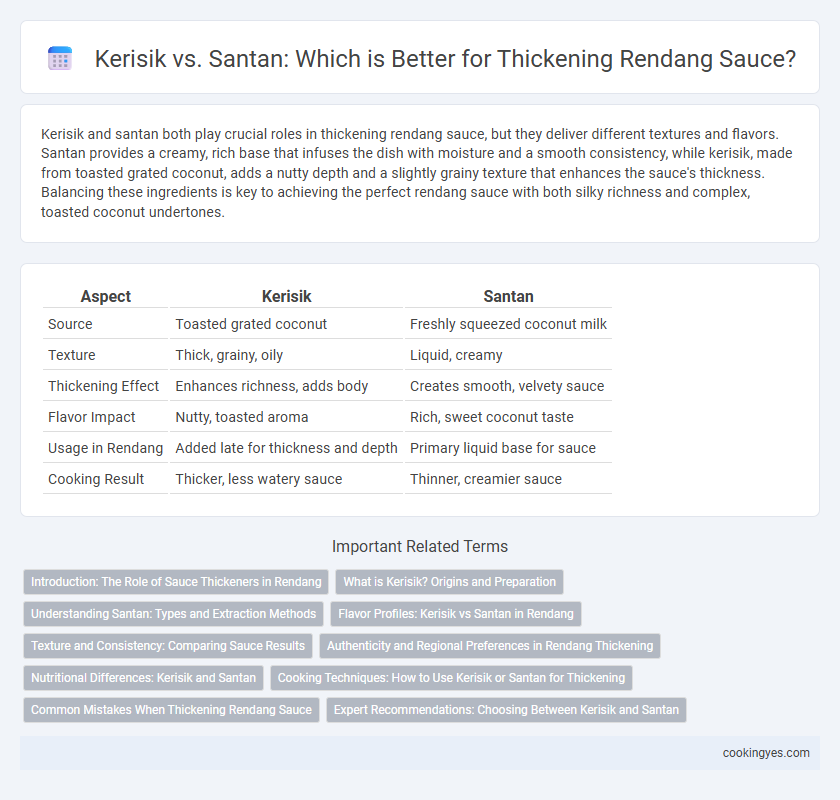Kerisik and santan both play crucial roles in thickening rendang sauce, but they deliver different textures and flavors. Santan provides a creamy, rich base that infuses the dish with moisture and a smooth consistency, while kerisik, made from toasted grated coconut, adds a nutty depth and a slightly grainy texture that enhances the sauce's thickness. Balancing these ingredients is key to achieving the perfect rendang sauce with both silky richness and complex, toasted coconut undertones.
Table of Comparison
| Aspect | Kerisik | Santan |
|---|---|---|
| Source | Toasted grated coconut | Freshly squeezed coconut milk |
| Texture | Thick, grainy, oily | Liquid, creamy |
| Thickening Effect | Enhances richness, adds body | Creates smooth, velvety sauce |
| Flavor Impact | Nutty, toasted aroma | Rich, sweet coconut taste |
| Usage in Rendang | Added late for thickness and depth | Primary liquid base for sauce |
| Cooking Result | Thicker, less watery sauce | Thinner, creamier sauce |
Introduction: The Role of Sauce Thickeners in Rendang
Sauce thickeners such as kerisik and santan play a crucial role in achieving the rich, velvety texture of Rendang. Kerisik, made from toasted grated coconut, imparts a nutty depth and enhances the sauce's body, while santan, or coconut milk, provides creaminess and moisture. The balance between these ingredients determines the sauce's consistency and flavor profile, which is essential for authentic Rendang.
What is Kerisik? Origins and Preparation
Kerisik is toasted coconut paste made by grinding freshly grated coconut until browned and fragrant, commonly used in Malaysian and Indonesian cuisines to add rich depth and nutty flavor to dishes like rendang. Originating from traditional Southeast Asian cooking, kerisik helps thicken rendang sauce while imparting a toasted coconut aroma that enhances the dish's complexity. Unlike santan (coconut milk), kerisik provides a more concentrated coconut essence and a slightly grainy texture, contributing both to the sauce's body and its distinctive taste profile.
Understanding Santan: Types and Extraction Methods
Santan, or coconut milk, is a crucial ingredient in rendang sauce, derived from grated coconut flesh through traditional extraction methods such as pressing and squeezing to produce varying thicknesses. There are two primary types of santan used in cooking: santan kental (thick coconut milk) that provides richness and creaminess essential for rendang's texture, and santan cair (thin coconut milk) which is often added later in cooking to balance moisture and enhance flavor. Understanding these types and extraction techniques ensures the perfect consistency and depth for authentic rendang sauce.
Flavor Profiles: Kerisik vs Santan in Rendang
Kerisik, made from toasted coconut, adds a nutty, caramelized depth to rendang's sauce, enhancing its complexity and richness. Santan, or coconut milk, provides a creamy, smooth texture that balances the spices with a subtle sweetness and moisture. The choice between kerisik and santan influences rendang's flavor profile by either intensifying the toasted coconut aroma or emphasizing a mellow, velvety finish.
Texture and Consistency: Comparing Sauce Results
Kerisik, made from toasted grated coconut, imparts a rich, nutty flavor and a thicker, grainy texture to rendang sauce, enhancing its dense and hearty consistency. Santan, or coconut milk, contributes a smooth, creamy texture that creates a more fluid and luscious sauce, ideal for balancing rich spices in rendang. Combining kerisik with santan allows for a unique blend of creamy and textured sauce, achieving optimal thickness and mouthfeel characteristic of traditional rendang.
Authenticity and Regional Preferences in Rendang Thickening
Kerisik, toasted grated coconut, adds a nutty depth and traditional texture essential to authentic rendang sauces, particularly favored in Malaysian rendang recipes for its rich aroma and thickening properties. Santan, or coconut milk, commonly used in Indonesian rendang variants, provides a creamy, smooth consistency but can result in a lighter sauce compared to the robust density achieved with kerisik. Regional preferences influence the choice between kerisik and santan, with kerisik preferred in regions valuing texture and flavor complexity, while santan is chosen for a silkier, more fluid rendang sauce.
Nutritional Differences: Kerisik and Santan
Kerisik, made from toasted grated coconut, is rich in fiber and contains healthier fats with lower saturated fat content compared to santan (coconut milk), which is higher in calories and saturated fats due to its liquid, creamy nature. Santan provides a creamy texture and essential nutrients like iron and magnesium but may contribute to higher cholesterol levels if consumed in excess. Choosing kerisik for rendang sauce thickening offers a more nutrient-dense option with less fat, promoting a healthier balance of macronutrients in traditional dishes.
Cooking Techniques: How to Use Kerisik or Santan for Thickening
Kerisik, made from toasted grated coconut, adds a rich, nutty flavor and thickens rendang sauce by absorbing liquid and enhancing texture through slow simmering. Santan, or coconut milk, contributes creaminess and natural fat, thickening the sauce as it reduces during prolonged cooking, creating a velvety consistency. Combining kerisik with santan in traditional rendang balances flavor depth and sauce thickness, using controlled heat to prevent separating and achieve an optimal, luscious texture.
Common Mistakes When Thickening Rendang Sauce
Using kerisik instead of santan to thicken Rendang sauce often leads to overly dense texture and altered flavor profile, as kerisik is toasted coconut paste and much more concentrated. A common mistake is adding kerisik too early or in excessive amounts, which can overshadow the delicate balance of spices inherent to Rendang. Santan, particularly thick coconut milk, is preferred for authentic Rendang sauce thickening because it provides a rich, creamy consistency while allowing the complex spice blend to infuse properly.
Expert Recommendations: Choosing Between Kerisik and Santan
Experts recommend using kerisik for authentic rendang sauce thickening due to its rich, nutty flavor that enhances the dish's complexity. Santan, or coconut milk, provides creaminess and a smooth texture but can dilute the depth of traditional rendang flavors if overused. Chefs suggest balancing kerisik and santan carefully to achieve the ideal thick, aromatic sauce characteristic of classic rendang.
Kerisik vs Santan for Rendang Sauce Thickening Infographic

 cookingyes.com
cookingyes.com